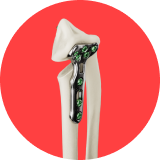Perform the best correction to fully restore the patient’s mobility


Restore the patient's anatomy, based on the contralateral arm

Reestablish the neutral glenoid plane taking as reference the scapular axis of the patient.

Reduce up to 50% of surgical time, all in benefit of your patient.

Get a detailed Digital Surgery, simulating the ideal correction and the perfect implant and screws position.

Get a visual 3D analysis of the patients anatomy by overlapping the patient’s pathological and healthy contralateral arm.
Get a digital surgery simulation including the ideal osteotomy plane and the needed correction to obtain the maximum radioulnar’s joint congruence


Get a recommendation on Implant sizes and Screws lengths and directions

Go one step forward with our Patient Specific Central PIN Positioning Guide
With our Patient Specific Surgical Instruments, be able to: – Drill all the implant screws holes in the perfect direction to achieve the maximum implant grip and place the implant as planned – Perform the ideal osteotomy to obtain maximum correction



Bring your surgery to the next level. Get a full personalised metaglene system perfectly adapted to your patient

Avoid the instability and undercorrection that can come with a maladaptation of the standard implants. Our excellence solution includes a patient specific implant to ensure full adjustment.
Plan down to the last detail. You will have available each of the screws and instruments you need, specially chosen for each surgical case so that you don’t have to worry about anything.










The Reverse Shoulder Artrhoplasty is indicated for the treatment of shoulder osteoarthritis and proximal humeral fractures.

This product is compatible with the following prothesis:
Other implants coming soon, ask for yours here!

Need more information? Download our case examples:
Marcoin, A., Nerot, C., Lestra, T., Blasco, L., Ferrier, A., Siboni, R. and Ohl, X., 2020. The precision of patient-specific instrumentation guides for the positioning of the glenoid component in total reverse shoulder arthroplasty: an in vivo scanographic study. International Orthopaedics, 44(9), pp.1761-1766
Villatte, G., Muller, A., Pereira, B., Mulliez, A., Reilly, P. and Emery, R., 2018. Use of Patient-Specific Instrumentation (PSI) for glenoid component positioning in shoulder arthroplasty. A systematic review and meta-analysis. PLOS ONE, 13(8), p.e0201759.
Walch, G., Vezeridis, P., Boileau, P., Deransart, P. and Chaoui, J., 2015. Three-dimensional planning and use of patient-specific guides improve glenoid component position: an in vitro study. Journal of Shoulder and Elbow Surgery, 24(2), pp.302-309.
Boileau, P., Cheval, D., Gauci, M., Holzer, N., Chaoui, J. and Walch, G., 2018. Automated Three-Dimensional Measurement of Glenoid Version and Inclination in Arthritic Shoulders. Journal of Bone and Joint Surgery, 100(1), pp.57-65.
Srivas, P., Kapat, K., Dadhich, P., Pal, P., Dutta, J., Datta, P. and Dhara, S., 2017. Osseointegration assessment of extrusion printed Ti6Al4V scaffold towards accelerated skeletal defect healing via tissue in-growth. Bioprinting, 6, pp.8-17.
Xiong, Y., Wang, W., Gao, R., Zhang, H., Dong, L., Qin, J., Wang, B., Jia, W. and Li, X., 2020. Fatigue behavior and osseointegration of porous Ti-6Al-4V scaffolds with dense core for dental application. Materials & Design, 195, p.108994.

I have performed a lot of Tailor Surgeries, saving sustancial surgical time. Now I’m dedicating this time to research!